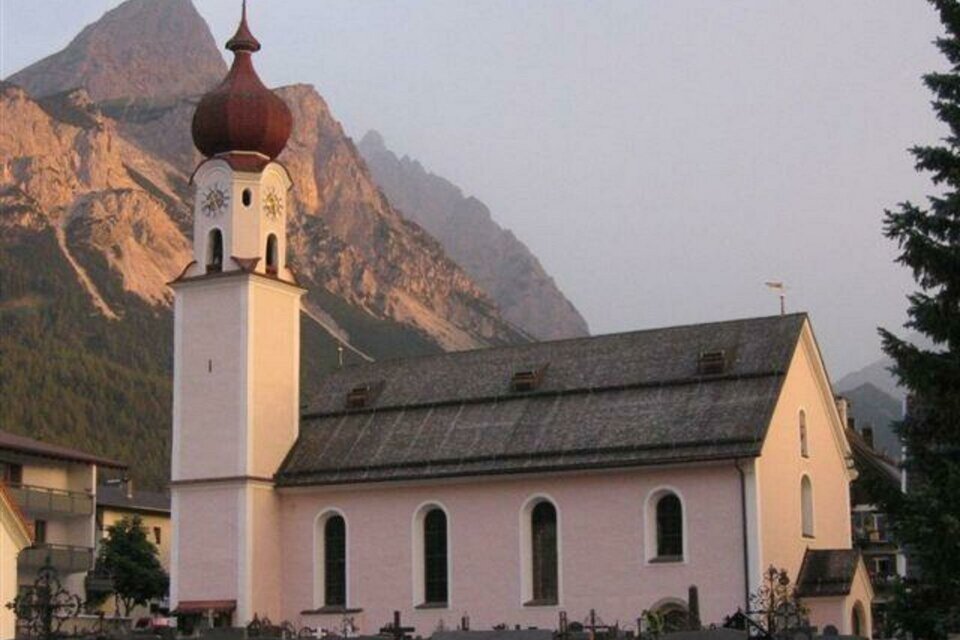Parish Church | Ehrwald
Zu unserer lieben Frau Maria Heimsuchung
1640-48: Construction of the first church | 15 Aug. 1648: Consecration of the church "Zu Unserer Lieben Frau Maria Heimsuchung", the cemetery and the tower with two bells by the Brixen auxiliary bishop Jesse Perkhofer | 1688 a curacy was endowed for Ehrwald. In 1729, under the first curate Georg Sailer, the church was completely renovated and this new building was consecrated in 1734 by the Brixen prince-bishop Count von Sarnthein. In 1739 the church received its first organ, donated by Mathias Guem from Ehrwald. In 1769 the spire was replaced by an onion dome by master carpenter Christian Samwöber (Somweber). In 1784 the church was extended once again and a double gallery was built. The high altar is by Ignaz Falbesoner from Nassereith, the side altars are by Johann Spielmann from Ehrwald. The high altarpiece is from the old high altar of the first church and has been restored several times since then. The side altarpieces were painted by Ehrwald-born Josef Anton Hochenegg and Tyrolean artist Joseph Arnold. The top paintings are also the work of painter Hochenegg. On the refectory to the right and left are paintings by Kaspar Jele. The ceiling was painted in the 19th century by the Ehrwald church painter Josef Spielmann. The pictures are based on paintings by the Brixen painter Georg Mader. The saints Joachim and Anna (for the married couple) were made by Ignaz Falbesoner from Nassereith, the statue of the Immaculata by Seraphin Eberhart. The two stained glass windows in the chancel from the Tyrolean Stained Glass Institute showed the Annunciation of the Lord (right) and the Nativity (left) until 1939. In 1868, the church received a parapet organ on the second gallery by the organ builder Franz Weber from Oberperfuss. In 1874 the church tower received the first large and coherent peal of bells from the bell foundry Graßmayr. The founder was Josef Anton Schennach from Ehrwald. In 1891 Ehrwald became an independent parish. In 1916, the bells had to be handed over for weapons production during the First World War. Only the small death bell remained. In 1923, four new bells from the Adler bell foundry in Reutte were purchased and consecrated. In 1928 the new cemetery chapel was completed. The old death bell was hung in its tower. In the 1920s, the Christmas cot, a wooden cot by master painter Pernlocher from Thaur and master carpenter Schretter from Ehrwald, was set up. From 1939 to 1941 the church was renovated. In 1943, the bells had to be delivered again for war purposes. The old death bell from the cemetery chapel served as a replacement. In 1948 four new bells from the bell foundry Graßmayr in Innsbruck were consecrated. The large bell weighs 940 kg. From 1960 to 1967 the church was renovated according to the modern spirit of the times and the influences of the Second Vatican Council. As early as 1963, a marble main altar (then called the "people's altar") was installed and consecrated by Bishop DDr Paulus Rusch in 1965. Since then, it has been adorned by the huge unity fresco by the local artist Roman Fasser from 1963. The stained glass windows from 1941 were removed on the recommendation of the Office for the Protection of Historical Monuments so that the church interior could be better lit by white glass. Many paintings, figures and objects of the church inventory were also removed from the church during this time of the "iconoclasm of the 1960s" and sold or given away. Only the backdrops of the baroque Holy Sepulchre were "mothballed" in the attic of the chapel of burial in the cemetery in 1955, after being put up for the last time, and thus fortunately survived the period of removal. In 1984, the beautiful Holy Sepulchre with its more than 90 coloured glass balls could celebrate its resurrection after its accidental discovery. In the course of this church renovation, a new organ was built in 1966 from parts of the old Franz Weber parapet organ by the organ building company Reinisch-Pirchner from Steinach am Brenner with a modern case corresponding to the time (design by the provincial conservator Dr. Menardi). From 1985 onwards, attempts were made to restore the original character of the church, as far as possible, by means of a new renovation and various works in the following years up to the present day. OUR CHURCH TODAY: The altars (the high altar with altar leaf and tabernacle as well as the side altars) and the pulpit with a depiction of the parable of the sower still date from ancient times. The church has Zeiller Stations of the Cross, but also a modern Stations of the Cross by the Ehrwald-based artist Henri Dante Alberti from the 1960s, which can be seen under the gallery. The new main altar was designed in 1985 by local artists Wolfgang Schennach and Walter Bader with the assistance of master carpenter Alois Posch.
Opening hours
Church services
Sat: 6 pm
Sun- and public holidays: 10 am
Tue: 7 pm
Sat: 6 pm
Sun- and public holidays: 10 am
Tue: 7 pm
03/01/2024 - 03/01/2026
Monday
00:00 - 23:59 o'clock
Tuesday
00:00 - 23:59 o'clock
Wednesday
00:00 - 23:59 o'clock
Thursday
00:00 - 23:59 o'clock
Friday
00:00 - 23:59 o'clock
Saturday
00:00 - 23:59 o'clock
Sunday
00:00 - 23:59 o'clock




